An Application of Foreign Internal Defense through Civil Affairs Operations in the Upper Huallaga Valley, Peru
Francisco M. Hernandez
“America’s future abroad is unlikely to resemble Afghanistan or Iraq, where we grapple with the burden of nation-building under fire. Instead, we will work through and with the community of nations to defeat insurgency, assist fragile states and provide vital humanitarian aid to the suffering.”
- LTG William Caldwell, FM 3-07, Stability Operations.[i]
Introduction
The roles performed by U.S. Civil Affairs (CA) elements in Peru have changed dramatically in the past three years. What began as operating out of the U.S. Embassy in Lima for most of 2011, evolved to conducting field operations in the Upper Huallaga Valley (UHV) emergency zone by the end of 2013. The UHV was once a strong hold of Sendero Luminoso (SL) in Peru. After extensive efforts by the Government of Peru and the U.S. Country team in implementing the ‘San Martin Model’ to support alternative development programs following coca eradication, conditions were set for the Civil Military Support Element (CMSE) to project into the field and partner with the National Commission for Development and Life without Drugs (DEVIDA), the Peruvian National Police (PNP), and other key players in the UHV.[ii] With the rapid success of CMSE Peru in 2013, the U.S. Country Team and the Civil Affairs community, with the support of the Peruvian Army and DEVIDA, expanded the capacity of CMSE Peru by bringing in a second Civil Affairs Team (CAT). Both CATs supported the U.S. Country Team, U.S. Southern Command (USSOUTHCOM), Special Operations Command-South (SOCSOUTH), and the Government of Peru’s (GoP) goals and objectives through an optimized Foreign Internal Defense (FID) plan.[iii] Joint Publication 3-22, Foreign Internal Defense defines FID as “participation by civilian and military agencies of a government in any of the action programs taken by another government or other designated organization to free and protect its society from subversion, lawlessness, insurgency, terrorism, and other threats to their security in support of the of Host Nation Internal Defense and Development (HN IDAD) program.” Viewing the role of the CMSE through the “Optimized FID Lens” provides an effective framework for guiding operations in the UHV to meet the objective of the country team and the GoP.
Thesis
CMSEs support Optimized FID through Civil Affairs Operations; networking and sharing of information and resources; communication and support of the larger strategic goals; and engage collaborative groups and networks that provide solutions to the complex problems in which today’s Civil Affairs operators find themselves. These functions and priorities serve the Civil Affairs community overseas and abroad in their support of Integrated Country Strategies and campaign plans worldwide and the same can be said for operations conducted in Peru.
The purpose of this article is two-fold. First is to highlight how Civil Affairs Teams executed FID through the application of the Village Stability Operations (VSO) and Counterinsurgency (COIN) principles learned in Afghanistan during the Global War on Terrorism.[iv] The second purpose is to demonstrate how the combined efforts of CMSE 823 and CAEP 8223 utilized the principles of FID and the tenants of COIN to support HN IDAD programs.[v]
Background
Since FY 2007, USASOC’s 95th Civil Affairs Brigade (A), Fort Bragg, N.C.; provide training and manning of CMSEs in support of Theatre Special Operations Command (TSOC) civil-military engagement (CME) strategies. [vi] However, the growth of the CA branch with the addition of FORSCOM’s 85th Civil Affairs Brigade presented an opportunity to have teams from the 95th CA BDE (A) and the 85th CA BDE experience mutually supporting efforts while conducting joint Civil Affairs Operations (CAO) in support of the same Integrated Country Strategy. That opportunity set off a series of events, not all error free, that saw a USASOC, 95th CA BDE (A) CMSE team working alongside a FORSCOM, 85th CA BDE Civil Affairs Engagement Program (CAEP) team in the UHV from mid-November 2013 to mid-May 2014.
During the deployment to Peru, CMSE 823 and CAEP 8233 fell under the Special Operations Command Forward (SOCFWD) and under operational control of the Special Operations Liaison Officer (SOLO).
Timeline and Methodology: Initial Methodology
CMSE 823 began the deployment in early September 2013, with the mission of supporting the U.S. Country Team’s post eradication and alternative development programs. This was a broad mission that needed refinement beyond the conventional mission out-brief guidance that all deploying CATs are accustomed to receiving prior to a deployment. With the rapid pace set up by the previous CMSE and their notable successes, there was little time to refine the mission initially. Coupled with the redeployment of the Security Cooperation Office’s (SCO) Civil Military Planner, the transition of SOLOs, and the 19 day Government Shutdown in October 2013, the first 90 days were complete with hiccups, counseling, missed benchmarks and minimal measurable effects. It is not to say that foundations for success later in the deployment had not been laid; however, during those September – November months it was easy for not only CMSE 823 to identify team shortcomings but for others to identify them as well. While running out of the blocks, CMSE 823 was aware of a three things. First, missions will not stop. Next, CAEP 8223 and a Civil Military Planner from USSOUTHCOM would be inbound. Finally, in order to support the long term post eradication and alternative development efforts of the GoP, there had to be a legitimate security force in place that had the support of the people and that could oppose any counter-state insurgency.
On October 2, just off a seemingly successful Relief in Place (RIP), CMSE 823 was invited by General Walter Sanchez, Jefe del Alto Huallaga de Frente Policia Nacional (PNP), to a seeming unacknowledged little ceremony for the opening of the newly minted Monzon Capital Comisaria (police station). This event was to take place deep within the Monzon Valley, an often inaccessible location during the November to March rainy season and sits approximately 55km from Tingo Maria. This event started into motion the dynamics that would ultimately set the conditions for CMSE 823’s measures of effectiveness. During this event, CMSE 823 was introduced to the Oficina de Participacion Ciudadana (OPC), the PNP department who was tasked with supporting community outreach programs within the PNP’s operational footprint.
During the month of October, CMSE 823 participated in three additional reopenings of PNP comisarias throughout the Monzon Valley that would essentially be providing security coverage for the entire 85km length of the Monzon Valley along its lone access point. Each comisaria would be charged by GEN Sanchez with identifying an oficial or sub-oficial (officer or non-commissioned officer) to support the work with the OPC department and identify citizens from the outlying communities to participate in the OPC’s Junta Vecinal (neighborhood watch) program and in the words of GEN Sanchez, “realizar acciones cívicas que nuestras comunidades quieren y necesitan, demostrándoles que nos preocupamos por su bienestar y seguridad en este nuevo Valle del Huallaga,” which translates to “perform civic actions that our communities want and need, showing them that we care about their welfare and safety in this new Huallaga Valley.” Prior to October 2013 the OPC was already a functioning department within the PNP, and having partnered with the previous CMSE while they supported DEVIDA civic action programs and projects, they had a model for successful civic engagements and programs; however, lacked the institutionalized training for their programs.
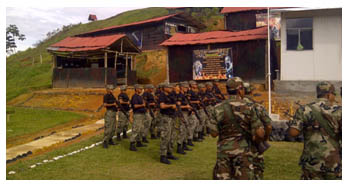
PNP stand ready for inspection by their commanding officer during an October 2013 opening ceremony of a Monzon Valley comisaria.
Following the October opening ceremonies of the Monzon Valley comisarias, OPC was now ready to begin the Junta Vecinal program’s growth. One of the goals of the Junta Vecinal program is to be the security extension of the PNP by providing a legitimate security presence and a voice for security matters within the more remote communities that fall outside of the PNP’s normal patrolling area. November 12 saw the eight member Junta Vecinal (Neighborhood Watch) Program induct seven new Junta Vecinal members. The OPC would manage the program from Tingo Maria; however, with limited resources and experience, OPC turned to CMSE 823 for additional support and on the job training. With that, the foundation was laid for a bottom up approach to expand the security footprint of the Partner Nation Security Forces (PNSF) within the UHV. We looked at this in much in the same fashion that VSO took root in Afghanistan with ALP expansion. CMSE 823 worked alongside the OPC as they identified new members for Junta Vecinal, and had multiple Key Leader Engagements (KLE) with OPC and Junta Vecinal. The KLEs were directed toward the sharing of experiences from our work in Peru and CAO in other countries, our support of FID, and the principles of COIN. During this time, CMSE 823 also learned about the experiences of OPC, Junta Vecinal and community members, and how the years under Sendero Luminoso had shaped their lives and current perceptions. It is important to note that the populace, particularly those ages 25-50, have deeply rooted sentiments of abandonment by PNSF during Sendero Luminoso’s years in the UHV. For this reason, it was identified as a critical task to CMSE to be able to provide a bridge for the populace with legitimate PNSF, utilizing the principles of VSO and COIN that had been successful in Afghanistan.

Frente Policia Nacional and Oficina de Participacion Ciudadana induct seven new Junta Vecinal members to serve as part of the Monzon Valley’s neighborhood watch program.
With the foundations for success laid as the end of November approached, CMSE 823 was ready to welcome CAEP 8223 to Peru. CAEP 8223 from Fort Stewart, Ga.; arrived November 24 ready to integrate with CMSE operations in the UHV. On paper the integration plan was solid; CMSE would schedule introductions and in-briefs with members of the country team, similar to those that would happen during a normal RIP, and once US Embassy in-processing was complete, CAEP would join CMSE forward in the UHV conducting CAO. Once forward in the UHV, the introduction of the CAEP to PN entities took place during a three day Civil Affairs’ Subject Matter Expert Exchange (SMEE) in Tingo Maria during the first week of December. Participants in the SMEE included members of DEVIDA, PNP, OPC, Junta Vecinal and Municipality of Tingo Maria leadership. This event marked the first CMSE/CAEP joint operation in the UHV. Utilizing a classroom setting, it allowed CMSE 823 and CAEP 8223 to share aspects of the CAO planning process with PNSF and PN GoP entities. Additionally, PNSF were able to demonstrate an understanding of the CA planning process, utilizing such tools as Areas, Structures, Capabilities, Organizations, People, and Events (ASCOPE).[vii]
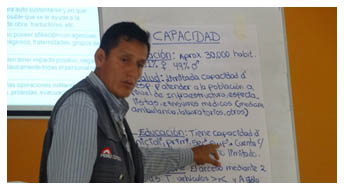
A member of Oficina de Participacion Ciudadana discusses the Civil Affairs planning process as part of a Subject Matter Expert Exchange.
Following the SMEE, CMSE 823 and CAEP 8223 began conducting CAO in the UHV, dividing the Areas of Responsibilities (AOR) East to West. Initially there was some refrainment by some PN entities to fully integrate a working relationship with the team because of the sudden introduction of another U.S. military element into the area. However, even with some of the challenges that manifested following their integration, CAEP 8223 continued to support PN efforts, such as “caravana” civic action programs, with their partnered Regional DEVIDA office in Eastern UHV with success. As December drew to a close, OPC and Junta Vecinal continued to grow in both capacity and capabilities. With CMSE 823 and CAEP 8223’s support, the Oficina de Participacion Ciudadana and Junta Vecinal participated in their first joint civic action program in Santa Rosa de Shapajilla on December 15, 2013. CMSE 823, CAEP 8223, OPC and Junta Vecinal with local leadership presented a "Chocolatada", a traditional Peruvian Christmas meal, for 600 residents of five neighboring communities. Of those who attended, 125 received medical attention. Additionally, for the 300 children in attendance, OPC provided entertainment and small gifts that were donated by local vendors from Tingo Maria. The event was an eye opener for CMSE 823 because of how positively and sincerely the community responded to the PNSF responsible for the area’s security and other essential programs like medicine and medical services; something that had not been recognized in many of the communities within the UHV in the past.

Local residents enjoy a “Chocolatada” sponsored by community leaders and Junta Vecinal members from the surrounding caserios.
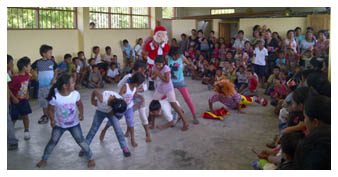
Oficina de Participacion Ciudadana provide entertainment to local children as part of their Christmas community outreach program.
Refinement of Methodology
With December winding to a close, Major Ian Davis, SOLO-Peru, recognizing that the relationship with the PNSF in the UHV, which has been growing steadily over the past year, would permit the furthered development of an applicable CAO model in the UHV. As had been the goal over the past year, this model could be taught and shared with PNSF once eradication operations transitioned into post eradications operations in the Valle de Rios Apurmac, Ene y Mantaro (VRAEM). He also noticed that the Civil Information Management (CIM) processes needed to be modified in order to increase visibility of CAO in the UHV, which would garner additional support from PN entities, as well as U.S. Country Team members. The collective decision was made by CMSE 823, CAEP 8223 and the SOLO to refine our missions to have more focus on an operational framework based on optimized FID utilizing VSO methodology. As pointed out in Optimizing Foreign Internal Defense to Counter Dark Networks: Direct and Indirect Approaches for Security and Development Efforts, “Security lines of effort focus on building the necessary human, physical, and virtual infrastructure to provide a safe and secure environment and enable legitimate rule of law. This effort not only increases Host Nation (HN) military and law enforcement services’ capacity to counter violent and illicit networks, it also leverages other HN actors with the capacity to deny dark network sanctuary and freedom of movement.”[viii]
CMSE 823 and CAEP 8223’s relationship with PNSF in the UHV was optimal for implementing a thorough optimized FID program. The teams would support OPC’s “bottom up” capacity, with programs such as Junta Vecinal, as they provide a secure environment in which the people connect to the GoP while supporting the development efforts of Peru. Over the next month, the CMSE and CAEP refined mission statements and CIM processes in order to become more transparent to both U.S. and Host Nation entities. This was done by utilizing programs such as Mission Partner Net (MPN) and All Partners Access Network (APAN) (https://www.apan.org). Here, CMSE and CAEP had access to shared resources, research, products, maps and subject matter experts in VSO, COIN, FID and CAO. Additionally, each team began creating unclassified versions of each post operation storyboard not only in English but also in Spanish. This allowed for our PNSF partners to see the successes we were highlighting and presenting to the members of U.S. Embassy and Country Team and our respective chains of command on PNSF accomplishments. The “flattened” communication of our operations, as pointed out in CJSOTF-A-VSO Handbook, was essential because CMSE activities can have immediate strategic implications and provide an instant “need to know,” which is also effective when conducting COIN operations.[ix] Using various other tools within APAN, such as Illuminating Networks and Collaborative Analysis (INCA) Project, we refined our Area of Operations and highlighted the importance of the Junta Vecinal program to providing security coverage in areas with minimal PNP patrols.
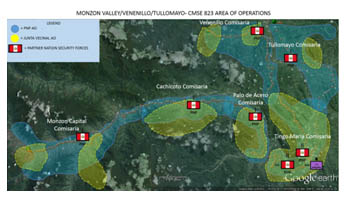
Civil Military Support Element’s Area of Operations along with PNP and Junta Vecinal coverage areas.
In January 2014, General Maximo Fidel Sanchez-Padilla, Jefe de Frente Policia Nacional de Alto Huallaga, took command of the PNP forces in the UHV. In February, Major Richard Yallicuna, commanding officer of the Oficina de Participacion Ciudadana and Sergeant 1st Class Arnulfo Benitez, CMSE 823’s Civil Affairs Noncommissioned officer briefed GEN Sanchez on the successes OPC was having in establishing positive relationships with isolated communities through civic engagements with the Junta Vecinal program. GEN Sanchez recognized the importance of the PNP relationship with the communities and directed the OPC to establish a civic action committee that would direct further focus the efforts of the OPC and Junta Vecinal program into those communities with limited access and resources. In order to maintain the momentum of December’s Joint “Chocolatada,” CMSE 823, CAEP 8223 and our partnering Military Information Support Team (MIST) along with OPC and Junta Vecinal conducted a Medical Civic Outreach Program (MEDCAP) on February 1, 2014 in Esperansa, Leoncio Prado, UHV. This location is significant because it was once the home of Sendero Luminoso’s ‘Artimio,’ who was arrested in February 2012 in Esperansa. The event was a great success and not because of the 240 people from the surrounding area who received critical medical care and medicines or for the 40 who received dental care. The event was successful because the local populace was able to see their local police force and local government representatives working together in a non-kinetic approach, as stated by Roberts and Everton, with the intent to “secure the population’s safety and support and undermine the enemy’s influence and control.”[x] In a location once under the control and influence of Sendero Luminoso, the area could be no more ideal to conduct FID through CAO in partnership with PNSF and GoP.
Application of New Methodology
With conditions set and the deployment now into March 2014, CMSE 823 began working systematically with the Oficina de Participacion Ciudadana in three areas: to expand their Junta Vecinal program in both capacities and capabilities, to use this program to enhance the legitimate security force that is supporting the post eradication and alternative development efforts of the Government of Peru, and to use our CIM processes to support INCA Project Peru. Using GEN Sanchez’s guidance, MAJ Yallicuna immediately appointed an OPC officer in each comisaria. OPC had several meetings throughout March on how they would conduct their own civic outreach programs as a standalone Frente Policia Nacional entity. The community of Castillo Grande, the adjacent community to Tingo Maria, was selected to be the site of OPC’s primer “accion civica” event. Castillo Grande was selected because of its close proximity to Tingo Maria and also because of the growing population in Castillo Grande due to the relocation of Peruvians from the Monzon Valley following the 2012/13 eradication efforts. Consequently, by conducting a civic action project in Castillo Grande, the OPC could have positive impacts and influence in a community still vulnerable to criminalist and narco-trafficking organizations because of the displacement; a key principle of COIN.
With PNP leadership’s backing, OPC conducted their first civic action project on April 5. CMSE 823 donated medicines that would be prescribed and issued by the PNP posta de salud doctors and pharmacist that OPC coordinated to support the event. In addition to providing medical services, OPC presented entertainment performances for the younger attendees. Those programs were aimed at providing awareness to ongoing social issues, such a teen pregnancy, underage alcohol consumption and the illegal drug use that continues to pose challenges to long-term social change following decades of acceptance under Sendero Luminoso. The event capstone was the induction of 13 new Junta Vecinal members by Coronel Lois Morales-Waron, Jefe de Division Policia Oficina Securidad – Leoncio Prado, while GEN Sanchez personally thanked each new member for their commitment to the well-being of the community. The 13 new Junta Vecinal members received “chalecos,” or vest, that would help them to be more recognizable in their caserios and instills a sense of pride in the position. The PNP Oficina de Participacion Ciudadana’s civic action program benefited over 600 people from all ages in a variety of activities, medical and dental services and educational outreach programs.
Findings
Needless to say, the second and third order effects of the Castillo Grande civic action program are expected to be significant. The PNP demonstrated their commitment to the security efforts of the community and their commitment to positive civic engagements with the populace through the OPC department and the Junta Vecinal program. Past successes of VSO in Afghanistan have followed similar success stories. Communities sought to establish credible security in remote and/or isolated regions in order to defeat an uprising of insurgent activities, which allows for legitimate governance brought in by the will of its citizens to lead and lastly, once conditions are set, implement programs to improve long term development. Though Peru is not an active war zone, the principles for success using VSO and COIN are no different.
The continued growth and success of the Oficina de Participacion’s Junta Vecinal program, as noted in the INFORME 2013/2014 OPC Junta Vecinal report, within the UHV cannot be understated.[xi] 16 of the 22 comisarias in the UHV now have an active OPC representative, who is working to expand the reach of the Junta Vecinal program. The growth from 15 Junta Vecinal members to over 100 in the span of seven months is a tremendous accomplishment, not only for the program, but for the OPC and PNP and their place in supporting the long term development of Peru following the demise of Sendero Luminoso. GEN Sanchez is continuing to work his Comisarios (Police Chiefs) to look for new approaches to engage with the populace, bring essential services to outlying communities (those most vulnerable to counter-state influencers), while supporting Peru’s counter-narcotics strategy. This will include future large scale civic action and outreach programs, to complement their small capacity events, in locations such as Yanajanca, San Martin on “Dia de la Bandera” (June 7, 2014) that will continue to enhance the populaces growing positive perception of the Frente Policia Nacional.
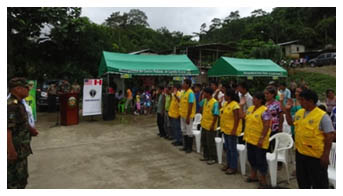
General Maximo Sanchez, Jefe de Policia del Alto Huallaga, observes as Coronel Lois Morales inducts the newest members of the Junta Vecinal program during the Oficina de Participacion Ciudadana’s premier civic action in Castillo Grande, UHV.
Conclusion
With the success the Oficina de Participacion Ciudadana has had with the Junta Vecinal program in the Monzon Valley, the expansion of the OPC and Junta Vecinal into Eastern UHV has provided CMSE 823 and CAEP 8223 with greater access to isolated communities within the region. By utilizing the same principles that have proved effective in the Upper Huallaga Valley, the Civil Military Support Element in partnership with the Oficina de Participacion Ciudadana are expanding the operational footprint and white space into the San Martin region, as well. With the utilization of the INCA Project Peru through APAN, future U.S. Government and Partner Nation elements will have instant access to the same tools and resources that are currently being utilized in country. Further, this information can be utilized to conduct Pre-mission Training and develop Campaign Plans to support the overarching strategies around security, governance and development. CMSE 823’s relationship with the OPC Department has opened the doors to other PNSF partnerships as well. Future Civil Affairs Teams will undoubtedly find success as they grow the partnership with the Peruvian Army’s Comando Asuntos Civiles (COAC) and apply the civic engagement model being utilized by the PNP’s OPC Department in the UHV. As PNSF capacities continue to grow, so will their abilities to conduct CAO that leads to operational results. With the continued application of the methodologies currently being utilized and the continued focus on creating a civic engagement model for our PNSF to adopt in other regions throughout Peru, including the VRAEM, Civil Affairs operators will continue to experience forward progress and accomplishments in their Civil Affairs Operations in support of Foreign Internal Defense.
The views expressed in this essay are entirely those of the author and do not necessarily reflect the views, policy, or position of the United States or Peruvian Governments.
All photos courtesy of Sergeant First Class Dominic J. Fagiano, 98th Civil Affairs Battalion (Airborne).
To request access to All Partners Access Network (APAN) and Illuminating Networks and Collaborative Analysis (INCA) Project- Peru, register for account access through https://www.apan.org/ and request access to INCA Project Community.
End Notes
[ii] For more information on the San Martin Model, see Cabieses, Hugo. “The ‘miracle of San Martín’ and symptoms of ‘alternative development’ in Peru”. Transnational Institute Drug Policy Briefing No. 34. December 2010. www.tni.org/files/download/brief34-en.pdf and Oficina de las Naciones Unidas Contra la Droga y el Delito’s (UNODC) “The Alternative Development Model of San Martin: Executive Summary. https://www.unodc.org/documents/alternative-development/San_Martin_english.pdf
[iii] Optimized Foreign Internal Defense (FID) framework consists of two dimensions: operational approaches (direct and indirect) and traditional IDAD efforts (security and development). Direct approaches focus on illuminating and interdicting the ideology, infrastructure, communication, activities, and resources of a dark network. They also seek to generate legal alternatives to illicit activity and compel malign actors to reintegrate into society. By contrast, indirect approaches focus on changing the environmental conditions that foster dark network operations. Using both approaches in tandem supports the interdiction of dark networks by lethal and nonlethal means. Together, they alter dark networks’ operational environment so as to make it inhospitable for the survival of the dark network. For more information, see Dailey, Bryan, Ian Davis, and Julius Tancred G. Managuelod. "Optimizing Foreign Internal Defense to Counter Dark Networks." Small Wars Journal. 07 November 2013. http://smallwarsjournal.com/jrnl/art/optimizing-foreign-internal-defense-to-counter-dark-networks
[iv] This process is described in great detail in the Combined Joint Special Operations Task Force- Afghanistan Village Stability Operations Bottom-up Counterinsurgency Handbook dated 01 April 2011 and is effectively stated by Deep, Alex in Village Stability Operations and the Application of Special Warfare Across the Contemporary Global Operating Environment, “the concept of unconventional FID has broader implications in US-policy towards combating terrorism or insurgency in countries that lack a strong central government presence in disputed territory. Working with and through a friendly government to build a security force capable of providing local officials the operational whitespace to expand basic services, rule of law, and development initiatives is an inherently unconventional task for SOF teams to execute in semi-permissive and denied areas alike.” Small Wars Journal. April 7, 2014. http://smallwarsjournal.com/jrnl/art/village-stability-operations-and-the-application-of-special-warfare-across-the-contemporary
[v] Tenants of Counterinsurgency and doctrinal implementation of Foreign Internal Defense can be found in Joint Publication 3-24, Counterinsurgency, 22 November 2013 and Joint Publication 3-22, Foreign Internal Defense, 12 July 2010.
[vi] See Field Manual 3-57, Civil Affairs Operations, (Incl. Change 1). 31 October 2011. Ch. 2-4 lists the functions of the USASOC CA brigade (A), which includes CMSEs.
[vii] See Field Manual 3-57, Civil Affairs Operations, (Incl. Change 1). 31 October 2011 provides doctrinal reference on the CA running estimates, which are the foundation for all aspects of the planning process. This process drives all CA operations and missions. A thorough understanding of these processes ensures mutual understanding of mission and end-state as CA operations support strategic operations from the operational and tactical levels.
[viii] See Dailey, Davis, and Managuelod. "Optimizing Foreign Internal Defense to Counter Dark Networks." http://smallwarsjournal.com/jrnl/art/optimizing-foreign-internal-defense-to-counter-dark-networks
[ix] See McChrystal, Stanley A. “It Takes a Network.” Foreign Policy. 22 February 2011. http://www.foreignpolicy.com/articles/2011/02/22/it_takes_a_network
[x] See Roberts, Nancy and Everton, Sean F. “Strategies for Combating Dark Networks.” Journal of Social Structure: Volume 12. https://community.apan.org/socom/iscc/regional/latin_america/inca_project/m/default.aspx
[xi] INFORME Nº-2013-FPH/DIVPOL-LP-OFIPACIU (2013/2014 OPC/Junta Vecinal report) is a report being created by Major Richard Yallicuna, Commander of Alto Huallaga’s OPC department on the Oficina de Participacion Ciudadana and the Junta Vecinal program within the Upper Huallaga Valley.
About the Author(s)
Comments
First – thank you to the author for writing this paper and to the Pentagon for allowing it to be published. The VRAEM is the new epicenter of coca production in South America and is critical to hemispheric security. There is very little open source reporting coming from the area which makes this paper even more important. A few comments:
MOPs/MOEs – it would have been beneficial if the author would have provided additional detail on his teams LOEs and the MOPs and MOEs they used to access the impact of their operations. I understand the security concerns with providing this level of information, but the paper left me interested in additional detail.
The author did describe, albeit vaguely, the challenges they faced in the initial weeks of the deployment and with the integration of CAEP 8233. Again, addition detail would have been nice. However, it is difficult for me to accept that the mission was a complete success as inferred towards the end of the paper. A paragraph or two at the end describing the challenges, how they approached them, and what they may have done better would be very helpful for people working in similar situations in the future. Without a certain level of self-criticism, the paper reads like an AAR with a military officer patting himself and his team on the back and not a serious contribution to the subject.
Finally, I found it very interesting that the author looked to Iraq and Afghanistan for counterinsurgency examples. The history of Peru is full of insurgency and counterinsurgency success and failure. This rich history of irregular warfare dates back to the colonial period and includes more recent episodes such as the MIR/ELN in the 1960s and Shining Path (and MRTA) in the 80s and 90s. Moreover the last 100 years in the region provide a wide range of irregular warfare examples that should be studied by those military professionals deploying to the VRAEM.
Again, thank you for providing insight into this under studied, yet critical, area of Peru.
